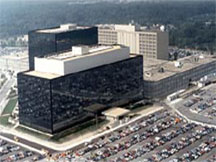National Security Agency
The National Security Agency (NSA), formally the National Security Agency/Central Security Service is part of the United States Department of Defense, with dual responsibilities:
- As a member of the United States intelligence community, it has the principal responsibility for collecting and processing signals intelligence.
- As the agency responsible for the "Information Assurance mission [to provide] the solutions, products, and services, and [conduct] defensive information operations, to achieve information assurance for information infrastructures critical to U.S. national security interests"[1]
Its headquarters are at Fort Meade, Maryland, although it has worldwide installations.
The headquarters, which consists of several large buidings, an impressive fence, and acres of parking lots, is reputed to have the most computers of any place on earth. Immediately outside one of the security gates is the National Cryptologic Museum and the National Vigilance Park, the latter holding three aircraft, one from each service, and of a type that was lost during SIGINT operations.
SIGINT personnel not only died on duty in aircraft. The first U.S. soldier killed in Vietnam belonged to an Army SIGINT unit. A large number of personnel were killed in the Israeli attack on the SIGINT ship, USS Liberty.
Executive organization
The Director, National Security Agency/Chief, Central Security Service is an active-duty, three-star officer from one of the military services. The Deputy Director, National Security Agency is a career civilian. There are usually some very senior staff specialists bearing titles such as Chief Cryptologist
Formation
During the Second World War, the Army and Navy had separate signals intelligence and communications security organization, which coordinated only informally. Depending on the service, tactical SIGINT, cryptologic development, strategic SIGINT, and cryptologic operations might be performed by autonomous organizations within a service department.
The Army and Navy formed a "Joint Operating Plan" to cover 1946-1949, but this had its disadvantages. The situation became a good deal more complex with the passage of the National Security Act of 1947, which created a separate Air Force and Central Intelligence Agency, as well as unifying the military services under a Secretary of Defense. While the CIA remained primarily a consumer, the Air Force wanted its own SIGINT organization, responsive to its tactical and strategic needs, just as the Army and Navy often placed their needs beyond that of national intelligence.[2] The Army Security Agency (ASA) had shared the national COMINT mission with the Navy's Communications Supplementary Activity (COMMSUPACT) - which became the Naval Security Group in June 1950. During and after World War II, a portion of Army COMINT assets was dedicated to support of the U.S. Army Air Corps, and, when the independent Air Force was created in 1947, these cryptologic assets were resubordinated to the new organization as the Air Force Security Service (AFSS).
U.S. Secretary of Defense James Forrestal rejected the early service COMINT unification plans. The Department of State objected to the next draft, which put the Central Intelligence Group/Central Intelligence Agency in charge of national COMINT. On 20 May 1949, Secretary of Defense Louis Johnson created the Armed Forces Security Agency.
To centralize common services, the Armed Forces Security Agency (AFSA) as a national organization. AFSA, was formed by secret executive order in 1948. Still, until NSA was formed in 1952, AFSA did not have the authority for central control of individual service COMINT and COMSEC. Policy direction of COMINT came from the U.S. Communications Intelligence Board (USCIB) which, in April 1949, requested $22 million in funds, including 1,410 additional civilian employees, to expand the COMINT effort.
Still interim organizations after the Korean War
NSA created
President Harry Truman, on 24 October 1952, issued a directive that set the stage for the National Security Agency, whose scope went beyond the pure military. NSA was created on 4 November 1952.[2]
The Service Cryptologic Agencies still had their own identity, even after the formation of NSA.
In 1955, ASA took over electronic intelligence (ELINT) and electronic warfare functions previously carried out by the Signal Corps. Since its mission was no longer exclusively identified with intelligence and security, ASA was withdrawn from G-2 control and resubordinated to the Army Chief of Staff as a field operating agency.
Under the US Marines,[3] the 1st Composite Radio Company was activated on 8 September 1959, continuing the World War II legacy.
References
- ↑ National Security Agency, Mission Statement
- ↑ 2.0 2.1 Thomas L. Burns (1990), The Origins of the National Security Agency, 1940-1952, National Security Agency
- ↑ USMC, 1st Radio Battalion, Vietnam Veterans. History - 1st Radio Battalion 1943 - 1973.
External Links
Executive Order Executive Order 12333--United States intelligence activities http://www.archives.gov/federal-register/codification/executive-order/12333.html


